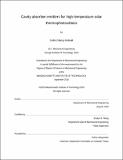Cavity absorber-emitters for high-temperature solar thermophotovoltaics
Author(s)
Kelsall, Colin Clancy
DownloadFull printable version (3.978Mb)
Other Contributors
Massachusetts Institute of Technology. Department of Mechanical Engineering.
Advisor
Evelyn N. Wang.
Terms of use
Metadata
Show full item recordAbstract
Solar energy has been an important component of the world's energy infrastructure for many years, but certain limitations have hindered its ability to become a primary source of renewable energy. In particular, intermittency and fundamental limitations on conversion efficiency have restricted adoption of direct photovoltaic conversion with PV cells. Recent developments in more advanced cell chemistries and concentrated solar power systems (CSP) seek to address some of these limitations and enable higher grid penetration of solar derived power. This thesis examines one of these such technologies, solar thermophotovoltaics (STPV), and presents opportunities to improve on past work in the field to enable higher conversion efficiencies and lower cost solar power. STPV power systems typically utilize a monolithic absorber-emitter component that is heated with concentrated sunlight through a highly absorptive surface. The monolith radiatively illuminates a low-bandgap PV cell from a different, spectrally selective emitter surface, producing electricity. This added spectral selectivity allows for improved photovoltaic conversion efficiencies compared to a standard PV cell illuminated with the solar spectrum. STPV systems, however, often operate above 1000°C and are hindered by substantial parasitic thermal losses. In this thesis we first present an overview of the loss mechanisms currently limiting STPV system efficiencies and some theoretical approaches to address these losses. Previously demonstrated STPV systems have significant drops in efficiency through re-emission losses from the hot absorber surface. Selective absorber coatings can reduce these losses; however, experimentally demonstrated efficiency improvements have been limited due to non-ideal spectral selectivity and high-temperature instability. Through an alternative approach, we present a purely geometric solution to mitigate re-emission losses by varying the area ratio, defined as the ratio of thermal emitter area to solar absorber area. We model how our solution could theoretically improve previously demonstrated STPV systems and also discuss the practical limitations of our approach. Secondly, we investigate the potential of integrating a cavity-based geometry for the absorber-emitter monolith in place of typical planar designs. By incorporating a cavity in place of the planar absorber-emitter, we take advantage of both increased absorption across the full solar spectrum and enable very high area ratios in a compact design. Third, we address how thermal gradients might develop within the absorber-emitter monolith and how these gradients might impact system performance. We present a numerical model capable of predicting PV cell performance degradation under uneven illumination resulting from emitter temperature gradients. Finally, we validate our model through experiments using cavities made from high-temperature refractory materials and a high-powered laser to emulate highly concentrated sunlight. By integrating a cavity-type absorber-emitter with state-of-the-art spectrally selective surfaces and filters, the maximum system efficiency demonstrated in previous works could be increased from 6.8% to upwards of 9% without any improvements in spectral selectivity. This cavity-type approach, which has the potential to improve solar absorber performance both for STPV and other solar thermal technologies, could help realize the full potential of these systems as efficient and useful methods of solar energy conversion.
Description
Thesis: S.M., Massachusetts Institute of Technology, Department of Mechanical Engineering, 2018. This electronic version was submitted by the student author. The certified thesis is available in the Institute Archives and Special Collections. Cataloged from student-submitted PDF version of thesis. Includes bibliographical references (pages 63-64).
Date issued
2018Department
Massachusetts Institute of Technology. Department of Mechanical EngineeringPublisher
Massachusetts Institute of Technology
Keywords
Mechanical Engineering.